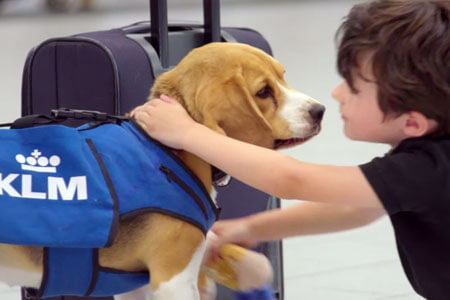
A Nose for Real-time Customer Service
Have you seen the viral video making the rounds about Sherlock, the adorable and very energetic dog “employed” by KLM Royal Dutch Airlines, who finds passengers’ lost items and returns them to their owners? When a KLM crew-member comes across an item — a child’s stuffed animal, a phone, a laptop — the highly trained canine retrieves it and puts his Beagle nose to work to hunt down the owner and return the lost belonging. You can imagine the delight of air travelers passing through KLM’s hub in Amsterdam as the quintessential real-time customer service agent runs past them to reunite a little girl and her favorite pookie-bear, the pup’s enthusiasm for delighting customers and making their experience with the airline a great one evident by his floppy ears and wagging tail.
What great customer service, you say, what a terrific ambassador of an airline devoted to delivering on their promises to their patrons. “An airline providing a prompt and useful service in a way that warms passengers’ hearts,” said a Washington Post article.
Unfortunately, and sadly, Sherlock is but a marketing ploy — but a really good one. KLM doesn’t employ a Beagle named Sherlock trained to find and return lost belongings. In reality, Sherlock is merely part of KLM’s campaign to showcase its Lost & Found program, which uses customer data such as seat number and location, phone numbers and public social media details to get forgotten personal possessions back into the hands of wayward travelers, with a success rate of about 80 percent.
If you’ve ever lost something on a flight or had your luggage sent to Albania when you were really going to Albany, you know that most of the time the best customer service in world won’t make you happy. But KLM boasts that it sometimes returns an item to a no-doubt grateful passenger before they even know it’s gone (now that’s real-time!).
Sure, Sherlock will put his paw prints on your heart, but you should also see him as a symbol for real-time customer service done right. The viral video — ok, it’s an advertisement —has garnered more than 12 million hits on YouTube alone since its release just a little more than two weeks ago. People loved it, yes, for the snugly Beagle, but also for the face (albeit a canine face) that the airline is out to put on its customer service efforts. It’s a heart-warming turn-on to know that an organization would be innovative and committed to training and engaging a creature to do what it does best to help others (aka, customers). (BTW, beagles and other canines use their noses in many service roles, including cancer and drug detection, so the premise of lost-and-found seems quite plausible.)
Still, having caught scent of the fact that the video was actually just a marketing pitch, many media outlets semi-derided poor Sherlock as a “fake,” a “lie,” a “PR stunt,” even saying “we can’t trust anyone anymore, not even the puppy in that KLM video.” Why the letdown and sarcasm? Simple, because we want to believe an organization would go to the inventive lengths to put the omniscient canine nose to work in the name of customer service, that they would endeavor to both serve and delight their stakeholders. We want to believe that great customer service is possible!
So, do your agents have a nose for real-time customer service? Giving them this sixth-scent (yes, pun intended) means that they have access to all the information they need. It means that you have you devoted time and resources to their training, to make sure that they can delight your customers and give them what they want, when they want it. Make sure you have more “Sherlock’s” on your workforce: ready, willing and able to deliver real-time service.
Back to Blog







